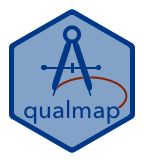Opinionated Approach for Digitizing Semi-Structured Qualitative GIS Data.
qualmap 
The goal of qualmap is to make it easy to enter data from qualitative maps. qualmap provides a set of functions for taking qualitative GIS data, hand drawn on a map, and converting it to a simple features object. These tools are focused on data that are drawn on a map that contains some type of polygon features. For each area identified on the map, the id numbers of these polygons can be entered as vectors and transformed using qualmap.
Motivation and Approach
Qualitative GIS outputs are notoriously difficult to work with because individuals’ conceptions of space can vary greatly from each other and from the realities of physical geography themselves. qualmap builds on a semi-structured approach to qualitative GIS data collection. Respondents use a specially designed basemap that allows them free reign to identify geographic features of interest and makes it easy to convert their annotations into digital map features. This is facilitated by including on the basemap a series of polygons, such as neighborhood boundaries or census geography, along with an identification number that can be used by qualmap. A circle drawn on the map can therefore be easily associated with the features that it touches or contains.
qualmap provides a suite of functions for entering, validating, and creating sf objects based on these hand drawn clusters and their associated identification numbers. Once the clusters have been created, they can be summarized and analyzed either within R or using another tool.
This approach provides an alternative to either unstructured qualitative GIS data, which are difficult to work with empirically, and to digitizing respondents’ annotations as rasters, which require a sophisticated workflow. This semi-structured approach makes integrating qualitative GIS with existing census and administrative data simple and straightforward, which in turn allows these data to be used as measures in spatial statistical models.
Cartographica Article
An article describing qualmap’s approach to qualitative GIS has been published in Cartographica. All data associated with the article are also available on Open Science Framework, and the code are available via Open Science Framework and GitHub. Please cite the paper if you use areal in your work!
Installation
The easiest way to get qualmap is to install it from CRAN:
install.packages("qualmap")
You can install the development version of qualmap from Github with the remotes package:
# install.packages("remotes")
remotes::install_github("chris-prener/qualmap")
Note that installations that require sf to be built from source will require additional software regardless of operating system. You should check the sf package website for the latest details on installing dependencies for that package. Instructions vary significantly by operating system.
Usage
qualmap implements six primary verbs for working with mental map data:
qm_define()- create a vector of feature id numbers that constitute a single “cluster”qm_validate()- check feature id numbers against a reference data set to ensure that the values are validqm_preview()- plot cluster on an interactive map to ensure the feature ids have been entered correctly (the preview should match the map used as a data collection instrument)qm_create()- create a single cluster object once the data have been validated and visually inspectedqm_combine()- combine multiple cluster objects together into a single tibble data objectqm_summarize()- summarize the combined data object based on a single qualitative construct to prepare for mapping
The primary vignette contains an overview of the workflow for implementing these functions.
Contributor Code of Conduct
Please note that this project is released with a Contributor Code of Conduct. By participating in this project you agree to abide by its terms.
